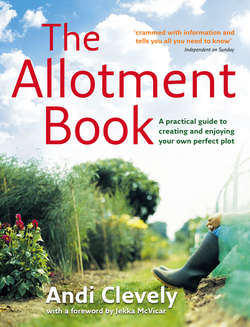Читать книгу The Allotment Book - Andi Clevely - Страница 38
SECURITY
ОглавлениеThe risks of forcible entry and theft from an unattended shed are high, and exempt from many association insurance schemes, but guidelines have been issued by police forces and site committees to help prevent loss.
▸ Provide a strong door and a large lock or padlock.
▸ Cover any windows with rigid wire mesh or grilles.
▸ Conceal screw fittings with metal plates.
▸ Use clutch head or ‘one-way’ screws because they are hard to remove.
▸ Fit a battery-operated alarm.
▸ Mark tools with barcodes or postcodes.
▸ Anchor the shed to piles so it is hard to topple over.
▸ Cover walls with trellis and plants for disguise and stability.
The greenhouse Adding a greenhouse to the site can enhance your growing options by offering a protected environment for tender crops and those at sensitive stages of growth, especially early and late in the season. Some gardeners consider a cold frame more essential and versatile (see pages 48–9), but the two structures can work hand in hand, and it is always an advantage to have an all-weather place with enough headroom for working comfortably. A greenhouse can accommodate larger plants, though, including permanent fruiting climbers such as a grapevine or trained apricots.
The minimum useful size is considered to be 2.4m (8ft) long by 1.8m (6ft) wide, or 1.2m (4ft) for a lean-to model, but even the smallest house can be an asset in a limited area, especially if you arrange the internal layout to exclude a permanent central pathway. Although a great variety of shapes is possible, the most serviceable is the traditional span design, with sides that are upright or gently inclining inwards, and glazed to ground level. Some kinds need a foundation similar to that used for sheds (see page 41), while many aluminium models can be pegged down into level ground.
MATERIALS Greenhouse frames usually come in softwood or aluminium, while the glazing is either glass or plastic.
Softwood is cheap, but the construction needs to be strong and this can reduce the total glazed area. Regular maintenance, even of comparatively durable cedar models, is essential for long life.
Aluminium-framed greenhouses are virtually indestructible and maintenance-free, and have thin glazing bars that maximize light transmission. They are more expensive than timber models, though, and need a very firm base to ensure rigidity.
Glass is the best glazing material because of its good light transmission and heat retention. It is, however, expensive, heavy and easily broken – a possible risk on allotments where vandalism is a problem, but if treated with care, it will last indefinitely.
